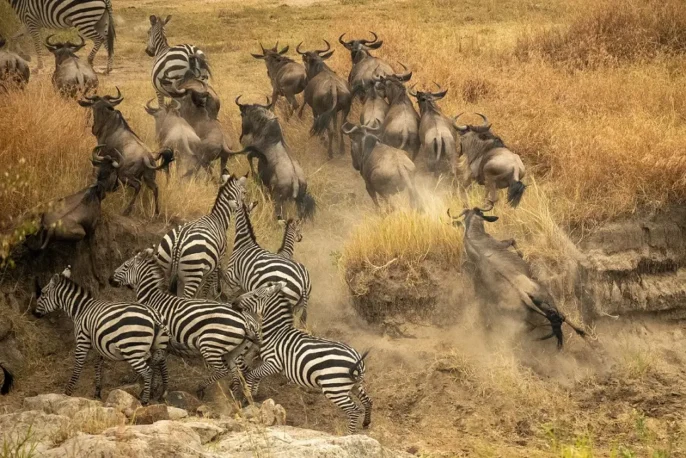Every year in East Africa, something amazing happens: millions of animals start moving across the land. This journey is called the Great Migration, and it is one of the most exciting wildlife events in the world.
Huge herds of wildebeests, zebras, and antelopes travel together in search of fresh grass and water. The Great Migration is not just about animals walking. It is a real-life adventure full of action and survival. You will see hungry lions, leopards, and cheetahs chasing prey, crocodiles waiting in the rivers, and baby animals taking their first steps. The drama, danger, and beauty of this event make it a top choice for travelers and nature lovers who want to see wildlife up close.
Are you wondering when is the Great Migration in Africa?
Quick Answer to When Is the Great Migration in Africa?
The best time to go is from July to October if you want to see river crossings in Kenya’s Masai Mara. If you want to witness calving season, then go between January and March in Tanzania’s Serengeti.
In the next sections, you will learn about the best times to visit, what you will see in each season, where to go, recommended safari camps, and how to plan your trip to catch the most exciting parts of the migration.
What Is the Great Migration?
The Great Migration is the yearly movement of over two million animals across the plains of East Africa. Most of these animals are wildebeests, but zebras and antelopes also travel with them. They move in a large circle between Tanzania’s Serengeti National Park and Kenya’s Masai Mara Reserve. This event is known as the Serengeti migration when it happens in Tanzania, and the Masai Mara migration when the animals reach Kenya.
It is not just about movement; it’s about survival. The herds are constantly pursued by predators like lions, cheetahs, leopards, and hyenas. Along rivers like the Grumeti and Mara, massive crocodiles lie in wait, turning river crossings into high-stakes moments of drama.
When to Go on the Great Migration?
Actually, knowing when is the Great Migration in Africa depends on what you want to see. This migration happens all year long, but different events take place in different months. Some travelers want to see baby animals being born, while others want to watch dramatic river crossings where animals risk their lives. No matter what you choose, there is always something exciting happening.
From January to March, the herds are in the Southern Serengeti in Tanzania. This is calving season, when thousands of baby wildebeests are born every day. It is a peaceful time, but predators like lions and hyenas are never far away. If you love cute animals and hunting scenes, then this is a great time to go.
From July to October, the herds move north to Kenya’s Masai Mara Reserve. This is the best time to see the famous Mara River crossings. Animals must cross the river, where crocodiles are waiting. It is the most thrilling part of the Masai Mara migration.
In between, the herds are always moving. From April to June, they travel through the central and western Serengeti. This time is greener and quieter, with fewer tourists. You can still see lots of animals, but without the big crowds. No matter the month, the Serengeti migration and the Masai Mara migration always offer unforgettable sights.
Month-by-Month Overview of Great Migration Dates
January – March: Calving Season in the Southern Serengeti
During these months, the Great Migration takes place in the Southern Serengeti, where the herds arrive for calving season. This is the time when thousands of wildebeests give birth to their young, which makes it one of the most peaceful and tender moments of the migration. If you are interested in seeing predator action, then this is the best time to visit. While the baby animals are growing, predators like lions and hyenas are ready to take advantage of the situation. It is a dramatic mix of cuteness and danger, and it is one of the most exciting parts of the migration.
Recommended Safari Camps: Olakira Migration Camp, Ndutu Safari Lodge
April – May: Green Season in Central Serengeti
As we move into April and May, the herds begin their movement towards the central Serengeti. The landscape turns lush and green, thanks to the rains, which create perfect conditions for grazing. The rains make the environment beautiful, but they can also cause some difficulty in travel, as the wet paths can be slippery and harder to cross. If you are wondering, “Where is the migration in April?”, then the herds are still in Tanzania, mostly in the Serengeti, but there is a calm before the more intense action of river crossings.
Travel Tips: Great time for photographers, quieter safari lodges, lower rates
June – July: Grumeti River Crossings Begin
By June and July, the migration starts getting more dramatic, with the herds crossing the Grumeti River in Tanzania. The crossings at this river mark the beginning of the more intense action, as crocodiles wait in the water. This is when the Great Migration starts to become more thrilling. The herds start their journey north, making their way to the Masai Mara. While it is not as famous as the Mara River crossings, the Grumeti River crossings are exciting and important milestones in the journey.
Recommended Camps: Singita Faru Faru, Grumeti River Camp
August – September: Peak of the Masai Mara Migration
The Mara River crossings in Masai Mara are the peak of the Great Migration. August and September are considered the bucket-list months for wildlife lovers. Here, you will witness the wildebeests, zebras, and other animals crossing the Mara River, which is filled with crocodiles. This is the most dramatic moment of the migration, where danger and survival are in full view.
Recommended Camps: Governors’ Camp, &Beyond Kichwa Tembo
October – November: Herds Return South
After the intense drama of the river crossings, the herds begin their return journey to the central Serengeti in October and November. The migration slows down, and the crowds of tourists also decrease. If you prefer fewer visitors but still want to see the herds, then this is an excellent time to visit. The weather is also more comfortable, as the heat starts to ease off.
Wildlife Notes: This is also a good time for spotting cheetahs and leopards in more open areas.
December: Calm Before the Next Calving Season
By December, the herds make their way back to the Southern Serengeti. This is a quieter time before the calving season begins again. The migration feels more peaceful, and the landscapes are beautiful. It is the perfect time if you are looking for a calm, magical experience before the cycle starts anew.
Where to Go During the Great Migration?
Serengeti National Park (Tanzania)
This large area is the main location for the Great Migration during the calving season (January-March) and when the herds are crossing the Grumeti River (June-July). The Serengeti offers more extensive viewing opportunities, with fewer crowds early in the year. It is ideal for those who want to witness newborns and predators up close.
Masai Mara National Reserve (Kenya)
As the herds move into Masai Mara (August-September), this is when the Mara River crossings occur. This dramatic crossing is one of the most popular events during the migration, where you can see the wildebeests and zebras making their way through the river while facing crocodiles. It is a bucket-list moment for many safari-goers.
Best Time to Visit Africa for Migration
Your best time depends on what you want to see:
- January to March for calving season in Southern Serengeti
- June to July for Grumeti River crossings
- August to September for Mara River crossings in Masai Mara
- October to November for quieter experiences during the return journey
No matter the season, each offers a unique glimpse into the largest terrestrial animal migration on Earth.
FAQ: Great Migration Dates and Tips
When is the best time to see the Great Migration?
July to October for river crossings, or January to March for calving.
What animals can I expect to see?
Wildebeests, zebras, Thomson’s gazelles, elands, Grant’s gazelles, lions, leopards, cheetahs, hyenas, vultures, and crocodiles.
Where should I stay for the best views?
Mobile camps like Ubuntu, Kimondo, and Olakira follow the herds. Luxury camps such as Sayari Camp or Singita offer year-round comfort and premium sightings.
Is the migration always on schedule?
The great migration dates vary slightly depending on rainfall and weather, but the general timeline remains consistent year to year.
Final Thoughts
Whether you’re planning your first safari or your fifth, knowing when is the Great Migration in Africa can make all the difference. The great migration dates shift slightly each year, but with this guide, you can time your visit perfectly.
With scenes of epic river crossings, tender calving moments, and heart-racing predator action, it truly is the best time to see great migration in all its natural glory. For nature lovers, photographers, and adventurers alike, this is the best time to visit Africa for migration experiences you’ll never forget.




